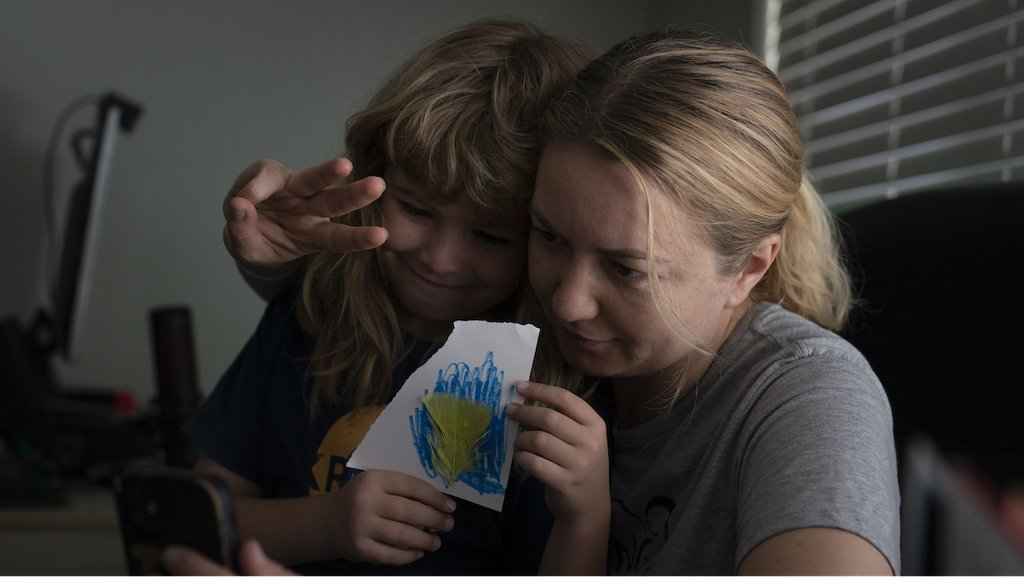Stand up for the facts!
Our only agenda is to publish the truth so you can be an informed participant in democracy.
We need your help.
I would like to contribute

With son, Volodymyr, holding a Ukrainian flag he made, Hanna Tverdokhlib, a 37-year-old Ukrainian immigrant, flashes a three-finger salute to her sister on a video chat in her apartment in Long Beach, Calif March 1, 2022. (AP)
If Your Time is short
-
After Russia invaded Ukraine in February 2022, President Joe Biden promised to welcome 100,000 Ukrainians to the U.S. About 271,000 Ukrainians have come to the U.S. since April 2022.
-
Many have entered under a new parole program that allows them to stay and work in the U.S. for two years.
-
As the war heads into its second year, most Ukrainians are in temporary programs without a path to citizenship and in immigration limbo.
A month into Russia’s invasion on Ukraine, President Joe Biden said that the U.S. would welcome 100,000 Ukrainians into the country.
"Many Ukrainian refugees will wish to stay in Europe, closer to their homes," Biden said in Belgium on March 24. But the U.S. "will welcome 100,000 Ukrainians to the United States with a focus on reuniting families," he said.
We’ve already welcomed tens of thousands of Ukrainians to the United States. And today, I’m announcing “Uniting for Ukraine,” a new program to enable Ukrainians seeking refuge to come directly from Europe to the United States.
— President Biden (@POTUS) April 21, 2022
Since then, Biden has fulfilled and even surpassed his promise. About 271,000 Ukrainians have come to the U.S. since April 2022, the Department of Homeland Security told PolitiFact. Most Ukrainians have come to the U.S. through a parole program that allows them to live and work here for two years.
Others came on tourist visas, some after crossing the U.S. southern border, or as refugees.
Now that they are here, many of these Ukrainians face an uncertain future: Their immigration status is temporary, and they have no clear path to U.S. citizenship.
A few weeks after Biden promised the U.S. would take in 100,000 Ukrainians, DHS announced the creation of the Uniting for Ukraine program. The program allows American citizens or lawful permanent residents to apply to sponsor Ukrainians. This allows Ukrainians to quickly reach the U.S. and get a work permit, bypassing immigration processes, such as refugee resettlement, that take longer to complete.
"Uniting for Ukraine has been highly positive, greatly reducing the wait time for those in need of safety from Russian aggression in Ukraine," said Jody McBrien, a University of South Florida professor and refugee resettlement expert.
About 115,000 people have come to the U.S. under Uniting for Ukraine, and about 32,000 others have been accepted to the program, but have yet to enter the U.S.
Homeland Security Secretary Alejandro Mayorkas has also designated Ukraine for Temporary Protected Status. DHS gives this designation to countries undergoing war, environmental disasters and epidemics.
People covered by Temporary Protected Status are protected from deportation and are allowed to work in the U.S. Ukrainians who entered the U.S. before April 11, 2022, are eligible for the status for an 18-month period.
Another group of immigrants who crossed the U.S. southern border after April 11 and before Uniting for Ukraine took effect April 21 received a one-year humanitarian parole to enter and work in the U.S.
Another 2,000 Ukrainians came to the U.S. as refugees between Oct. 1, 2021 and Jan. 31, 2023, according to a PolitiFact analysis of the U.S. State Department’s Refugee Processing Center’s data.
Although the one-year humanitarian parole, the two-year Uniting for Ukraine program and the 18-month Temporary Protected Status benefits have all provided reprieve to Ukrainians, these programs have also left beneficiaries stuck in limbo.
"These are all temporary solutions for what we can envision for many people will become more of a permanent situation," Rey Koslowski, an international migration expert at the University at Albany said, noting that an end to the war seems far off.
People who come in as refugees are allowed to apply for lawful permanent residence one year after their arrival.
But Ukrainians on humanitarian parole or under Temporary Protected Status have no clear path to citizenship. To stay here legally long-term, they’d need to adjust their immigration status; they could do so if they’re granted asylum or are sponsored by an employer or relative.
If the U.S. government doesn’t extend their current protections and if Congress does not pass a law giving Ukarinians a path to citizenship, this group could lose their work permits and be left in the U.S. without documentation.
"Uprooting due to tragedy is very difficult. Being uprooted a second time with no option to stay will increase the psychosocial toll for some," McBrien said.
In May 2022, Congress passed a law making Ukrainians in parole programs eligible for most benefits usually reserved for refugees, such as medical, food and housing assistance. Temporary Protected Status beneficiaries are not eligible for the benefits.
McBrien said many Ukrainians "will be anxious to return to their homeland when it becomes safe to do so. Others will struggle with war trauma and not want to go back, she said. "Some may have settled comfortably into an American lifestyle with a job and with children in school who have made new friends and moved on with their lives."
Meredith Owen, the policy and advocacy director at Church World Service, one of the nine refugee resettlement organizations in the U.S., said the Biden administration has relied too heavily on parole options rather than investing in the refugee and asylum systems, which provide permanent protections to people fleeing violence. She said the U.S. government needs to ensure funding is also being provided to refugee and asylum programs.
Koslowski, of the University at Albany, agreed, saying the U.S. government needs to ensure it has the infrastructure to process an impending uptick in asylum applications from Ukranians seeking to stay in the U.S. permanently.
Our Sources
Phone interview, Meredith Owen, director of policy and advocacy at Church World Service, Feb. 21, 2022
Phone interview, Rey Koslowski, director of the Master of International Affairs Program at University at Albany, Feb. 21, 2022
Email exchange, Jody McBrien professor at University of South Florida, Feb. 21, 2022
Email exchange, Department of Homeland Security spokesperson, Feb. 21, 2022
U.N. High Commissioner for Refugees, Ukraine Emergency, accessed Feb. 22, 2023
Wall Street Journal, Thousands of Ukrainians in U.S. Risk Losing Legal Status in April, Feb. 18, 2023
U.S. Customs and Border Protection, Nationwide Encounters, accessed Feb. 22, 2023
Migration Policy Institute, Welcoming Afghans and Ukrainians to the United States: A Case in Similarities and Contrasts, July 13, 2022
U.S. Department of Homeland Security, Secretary Mayorkas Designates Ukraine for Temporary Protected Status for 18 Months, March 3, 2022
PolitiFact, Donald Trump extended Temporary Protected Status for Haitians. Here's what that means, May 22, 2017
U.S. Citizenship and Immigration Services, Temporary Protected Status Designated Country: Ukraine, accessed Feb. 22, 2023
U.S. Department of Homeland Security, President Biden to Announce Uniting for Ukraine, a New Streamlined Process to Welcome Ukrainians Fleeing Russia's Invasion of Ukraine, April 21, 2022
Refugee Processing Center, Refugee Arrivals by State and Nationality, Jan. 31, 2023
Congress, H.R.7691 - Additional Ukraine Supplemental Appropriations Act, 2022, May 21, 2022
Office of Refugee Resettlement, Benefits for Ukrainian Humanitarian Parolees, accessed Feb. 22, 2023
Congressional Research Service, Ukrainian Eligibility for Selected Benefits Based on Immigration Status: In Brief, Nov. 29, 2022








































